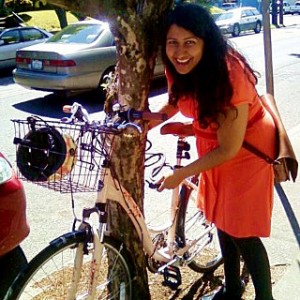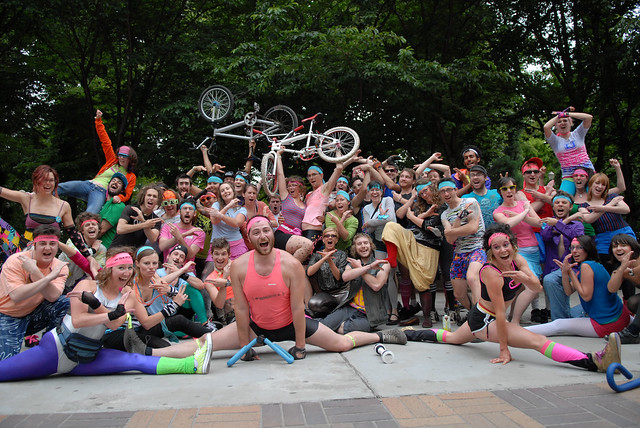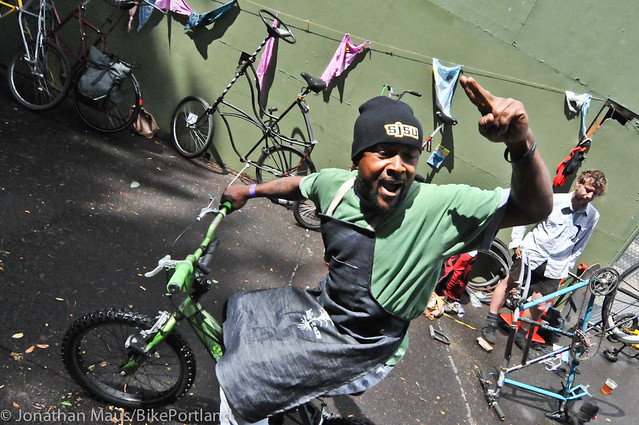This post is by columnist Taz Loomans.
Not long ago, I thought more bike lanes would save the world. In fact, my passion for a better environment for bicyclists and pedestrians was one of the reasons I moved to Portland.
Since then I’ve become disillusioned with the bike advocacy movement, largely because of its lack of racial and ethnic diversity.
According to the recent CNN article by comedian/activist W. Kamau Bell, called Gentrifying Portland: A tale of two cities, “Portland is 76 percent white. That’s a lot, for two reasons. 1) According to the 2010 census, the United States is 72% white, so Portland is whiter than America. 2) Portland is considered a major city. And we don’t associate major cities with whiteness,” he says.
I never associated the bike and ped advocacy movement with whiteness until I moved to Portland. I always assumed that progressive policies like better bike infrastructure and racial diversity would go hand in hand. But that’s not necessarily true, as I’ve learned in Portland.
“As non-diverse as Portland is, the typical bike fun ride is even less diverse ethnically, unfortunately,” admits bike fun organizer Chris McCraw.
Carl Larson, a fellow bike advocate, echoes this point. “There still seems to be a lack of racial and ethnic diversity in Portland’s bike fun,” he said. “More so than in the city’s biking population as a whole.”
The problem is not that people of color aren’t interested in bike infrastructure.
“Bike infrastructure is critical,” said Sam Baraso, a co-leader of the Environmental Professionals of Color and a senior policy analyst at Multnomah County. “It goes a long way to making cyclists’ daily commutes that much safer. While I’m plenty vigilant, I feel much more confident and safer biking here than other places I’ve cycled.”
“Bike infrastructure is super important to me,” said Kirk Rea, volunteer coordinator at The City Repair Project. “At the highest level, I see bike use as a powerful green technology that can reduce our negative impact on our environment. At smaller scales, bike infrastructure has the benefits of recreation, or play, and can help our health or livability. As people of color we need as many pro-health options as possible, as we statistically have higher rates of chronic illnesses such as heart disease and diabetes.”
Yet people of color seem largely absent from bike fun — a major outlet of bike activism. So what? you might ask. How is race even an issue in bike advocacy anyway?
Larson reminds us that “bike fun isn’t just fun, it’s a powerful advocacy tool, too. If [bike fun] events were more diverse, we would likely see faster, better supported, and more equitable changes to our streets.”
Rujuta Gaonkar, Program Manager of the Health Equity Initiative at Multnomah County Health Department, said race matters in bike advocacy because “when I think about all that I’ve heard with the bike lanes that went in on N. Williams, it’s clear that the people living in the corridor, who are some of the most significantly impacted by the changes that resulted from putting in bike lanes, weren’t even consulted when that endeavour was taken. How can the movement adequately take into consideration how biking and relationships to biking might look different in different communities if it is overwhelmingly white?”
“Infrastructure and equity in active transportation go hand in hand,” said Lale Santelices, the Community Cycling Center’s former collaborations manager. “The people and places that would benefit from more transportation options are often times the people and places that have less access to options and live in the most remote areas of the city.”
Rea agrees and says that “People of color have typically been left out of decision making when it comes to urban development, even when our neighborhoods are affected, and thus have experienced gentrification. Further developments need to be installed with care if we are to buy in.” Without a racially diverse group of people at the decision-making table, the bike advocacy movement won’t be able to serve diverse communities effectively.
Advertisement
Because Portland as a city is so white, cultivating diversity in any advocacy movement is hard work, but not impossible. The first step is to recognize the problem and acknowledge that not all is well. As Bell writes about Portland — and what can be said about bike advocacy in Portland — “Everything looks right, but something is definitely wrong.” McCraw agrees. “I think we have a lot of things to work on [in bike fun] – inclusion of younger and older riders as well as poorer and richer, and non-white,” he said.
The second step is to talk about it. One of the biggest hurdles I’ve found in Portland is the lack of willingness to openly talk about race issues among the white population. Noticing the lack of racial diversity in bike advocacy and bike fun and talking about it is an essential first step in making a change.
The third step is to take responsibility. Portland faces a unique problem with race because it is generally very liberal and progressive in its politics yet it lacks in racial diversity. Because of this juxtaposition, there tends to be some amount of passivity among the white liberal population about racial and ethnic diversity.
Bell writes, “Almost to a person they had the same type of reaction when I brought up Portland’s (to me) shocking lack of diversity. It was something to the effect of…Hipster – “YAY, PORTLAND!” Me – “Where are all the black people?” Hipster – “Oh yeah” Hipster looks down at their feet until I go away.”
Seven things anybody can do to help

(Photo: M.Andersen/BikePortland)
The only way to make progress around the issue of diversity in bike advocacy is to take responsibility for it and actively recruit people of color into bike advocacy and bike fun. Which leads me to the next step.
Take action! Here are seven ways how you can be active about bringing racial and ethnic diversity to your next bike ride or bike advocacy effort:
1. Baraso suggests: “Build relationships with people of color organizations, and do so long before you have something [like a bike ride] in mind so that it comes out of the relationship.” Rea emphasizes that “Leaders from various communities need to be at planning tables with leaders of bike fun.”
2. Priti Shah, Finance Director and Event Coordinator at The City Repair Project suggests: “Have signage in different languages. Make promo materials (photos, videos) of people of color on bikes. Help organizations that work with diverse ethnicities organize a bike ride/bike tour.”
3. “Partner with folks in marginalized communities to lead a ride more appealing to non-white-young-CIS-male demographics. I’m thinking things like a SOUL district ride, a ride to the Juneteenth parade, and one that is already on the Pedalpalooza calendar – the refugee ride,” says McCraw.
4. Watch who’s on your invite list. According to the 2010 census, 19.5% of Oregon’s 2014 population over the age of 18 identify as non-white. A good guideline to check if your ride is representative of the general population is to see if about 20% of your invite list includes non-whites. If you’re having trouble reaching this number, it’s time to become proactive and reach out to communities of color through organizations like – Coalition of Communities of Color, Center for Intercultural Organizing, Asian Pacific American Network of Oregon, African American Health Coalition, Immigrant & Refugee Community Organization, Latino Network, and Native American Youth and Family Center, among others, to get the word out about your bike ride to different communities.
5. Larson suggests that people start rides in more racially diverse areas of town. “Don’t start everything at Col. Summers Park, Salmon Springs Fountain, and Velo Cult. If you want to encourage a more diverse crowd to attend your event, consider starting it in a more diverse place like St. Johns, Lents or even Beaverton!”
6. Watch the cliquiness. Often you have to be in the know to feel accepted at bike fun events and people who aren’t aren’t always made to feel welcome. Santalices says that sometimes it feels like “you need to have all the gear, you have to know all the unspoken rules or you feel publicly shamed.”
And Larsen cautions against shaming people for wearing lycra or driving to bike fun events, which can exclude people of color that live in faraway communities. “Giving people a hard time for wearing lycra or driving a car can overlook the cultural and practical reasons people might have for doing both. It’s true: you don’t need special clothes for biking and bikes work great for most errands. It’s also true that some people, including many new immigrants, see biking as a symbol of recently-escaped poverty. They might only bike in lycra because they want community members to know “I’m doing this for fun! …not because I have to,” he says.
7. To make your bike ride more inclusive, don’t forget to go slow or have a sweep at the end of your rides. Rides that are aimed at experienced cyclists capable of doing long distances and going fast are great. But there are a lot of bike rides that aren’t about that, but sometimes bike ride leaders forget that not everyone is as experienced as they are. People new to biking or people who aren’t practiced riders may feel left behind at many rides, so it pays to go slow and have a sweep for those folks.
“If you are a privileged white man, there is nothing wrong with that,” said homeless advocate Ibrahim Mubarak said at the Reclaiming Space Confronting Oppression & Reclaiming Space panel at the 2016 Village Building Convergence. “It matters how you use that privilege. Do you use it to demean and oppress? Or do you use it to uplift?”
Will the current bike advocacy community use its privilege to direct its energy at the same old overwhelmingly white consituency? Or will it use it to actively recruit and seek out inclusion, diversity and equity?
Taz Loomans is BikePortland’s subversiveness columnist. Read her introductory column here.










